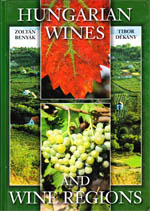Mor
View Mor in a larger map
Mor and its vicinity turn up in 12th century charters as parts of the Csokako castle manor. Documents dating from 1138 and 1231 mention the vineyards and serfs of Bodajk, a village adjacent to Mor, and, respectively, the vineyards of Csakbereny and Vajal (today a neighborhood in Mor). The name of Mor itself first surfaces in the 15th century. The steady development of the region’s viticulture was arrested by the Ottoman invasion in the 16th century. 28 of the 32 villages under the protectorate of the fortified castle of Csokako (“Jackdaw’s Rock”) perished in the ensuing Ottoman wars, and the abandoned vineyards soon ran wild. For the work of reconstruction we have to give credit to the German settlers who moved here in the course of the 18th century. Mor also benefited tremendously from the arrival of the Capuchin monks, who became the best vine-dressers in the area. The 18th century thus brought a fresh start to Mor instead of directly carrying on the ancient tradition. It was probably around this time that the Ezerjo grape first materialized in the region’s vineyards.
Mor reached the pinnacle of its fame in the 19th century. At least in part, its renown no doubt rested on its export of late-harvest sweet wines, which often fetched a price second only to Tokaji Aszu. The region emerged from the phylloxera epidemic with less damage than wine producing areas with cohesive soils, as the sandy loess here provided relative immunity against the pest. The district of Mor belonged to the Neszmely wine region until 1901, when the village applied for and received independent wine region status.
Many growers in Mor continue to rely on elements of traditional cultivation, including narrow spacing, bald-head training, and disbudding (which the locals call gyomlalas, or “weeding”). Uniquely, the Ezerjo is by far the most widely planted grape, followed by Chardonnay, Rajnai Rizling, Rizlingszilvani, Sauvignon Blanc, Sztirkebarat, and Tramini. This kind of varietal structure is actually rather typical of North Transdanubia, where viticulture has strong ethnic German roots.
Mor wines tend to be hard, fiery, and long-lived. The reputation of the region’s best-known wine, Mori Ezerjo, has been severely tarnished in recent times. This has to do with the fact that Ezerjo is a very fastidious grape that is rather sensitive to rot starting early in the fall. For this reason, many growers often harvest their Ezerjo at an early date to avoid damage. However, this invariably means less than ideally ripe grapes and, consequently, wines with an unpleasant bite. Those few willing to risk a late harvest are sometimes rewarded by a firm but elegant wine of great fire and personality. In the best years, Ezerjo is often vinified in the off-dry or semi-sweet style. The rare Ezerjo Aszu is a medium to full-bodied sweet dessert wine made from shriveled grapes attacked by botrytis.
In addition to its hallmark Ezerjo, Mor can boast some fine old vintages of Leanyka that are still impressively vigorous. Kiralyleanyka and Muscat Ottonel, two varieties recently recommended for the region, have produced wonderfully aromatic and trim wines. In the wines harvested from the best sites, the powerful acidity derived from the soil is balanced by a body to match, but it will always stay in the foreground. Many of the region’s wines may seem absolutely dry when they contain one to four grams of residual sugar. In some years, the early-ripening quality varieties may even yield wines on the semi-sweet side. A charming tradition that has been handed down by the ethnic Swabian dwellers is that of the wine soup, consumed as part of the revelry after the hard work of harvest. According to German custom, a variety of sweet pastry and biscuits are served with this soup, including kvircedli (Kwiezetl), Katzenpratzl (“cat’s paw”) and Nusstangli, a type of walnut bar.
Area: 730 hectares.
Climate: favourable, though cooler than the average. Mild winter, a lot of air motion, which is unfavourable for diseases. The rays of the sun reach a big part of the vineyards all day long in summer.
Vine varieties, wines: Ezerjó – neutral fragrance, full body compensating the strong acidity, manful, hard, elegant, in good years containing not fermented sugar, but of dry character. Rizlingszilváni – fine fragrance, good acids. Tramini – intensive fragrance and flavour – occasionally soft. Leányka – fragrant, light, elegant. Chardonnay – fine fragrance, fiery, full-bodied.
For more interesting information |
|
Hungarian wines and wineregions. Authors: Zoltán Benyák, Tibor Dékány. |
Terra Benedicta 2003: Tokaj and Beyond Authors: Rohály Gábor, Mészáros Gabriella, Nagymarosy András. |

